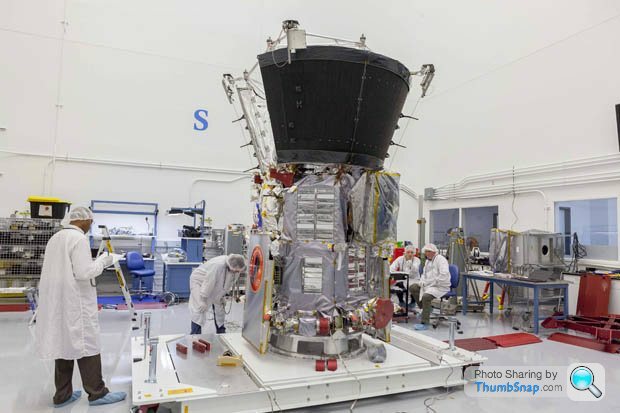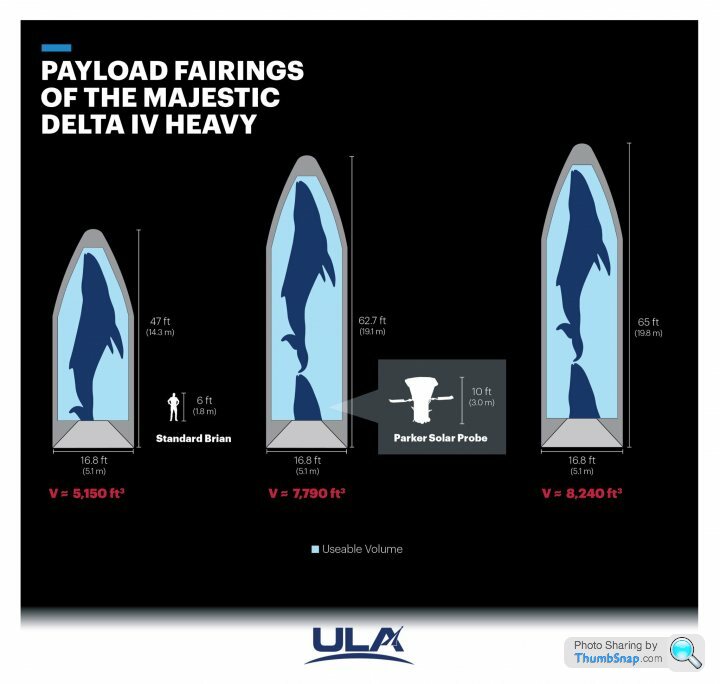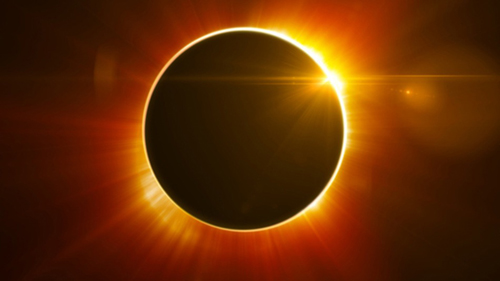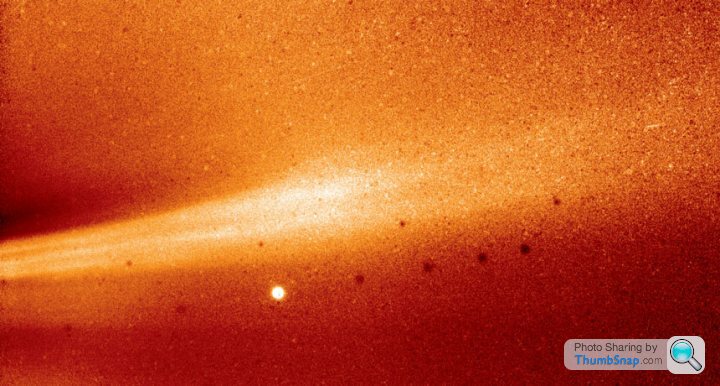Parker Solar Probe
Discussion
NASA's Parker Solar Probe is due to be launched atop a Delta 4 Heavy rocket on Saturday 11th August - from Cape Canaveral (08.48-09.33 UK time) and they're always impressive to see. First one for 2 years too.
The specially shielded probe will fly to 3.8 million miles from the Sun's surface, which is 7 times closer than any other spacecraft ever has. It'll study the solar winds and the surface of the Sun itself while braving intense solar radiation & heat of around 1,300 degrees Celsius.

It's not the largest thing we've ever put into space, but it'll eventually be the fastest man made object, getting up to around 430,000 mph (700,000 kph).
They're going to put it in an orbit between the Sun and Venus, using Venus's gravity to gradually lower the orbit for closer & closer passes of the Sun. This will require 7 passes of Venus over 6 years to bring it down to closest approach through the Sun's corona. This will start in late 2024, but they'll be able to gather data along the way.
https://www.nasa.gov/content/goddard/parker-solar-...
The specially shielded probe will fly to 3.8 million miles from the Sun's surface, which is 7 times closer than any other spacecraft ever has. It'll study the solar winds and the surface of the Sun itself while braving intense solar radiation & heat of around 1,300 degrees Celsius.

It's not the largest thing we've ever put into space, but it'll eventually be the fastest man made object, getting up to around 430,000 mph (700,000 kph).
They're going to put it in an orbit between the Sun and Venus, using Venus's gravity to gradually lower the orbit for closer & closer passes of the Sun. This will require 7 passes of Venus over 6 years to bring it down to closest approach through the Sun's corona. This will start in late 2024, but they'll be able to gather data along the way.
https://www.nasa.gov/content/goddard/parker-solar-...
Edited by Beati Dogu on Sunday 5th August 19:04
More whales & rockets:

With a human and the Parker Solar Probe to scale.
Seems like overkill to launch a diminutive spacecraft on a large $400 million rocket, but the energy requirements of this mission demand it. This particular Delta IV Heavy rocket has a third "kick stage" as well, which will help fire the probe towards Venus.
This will be the fastest object ever to leave the Earth's atmosphere. Beating a record of 36,400 mph set by the New Horizons mission during launch on an Atlas V in 2006.
Somewhat perversely, the high velocity is actually to slow down the spacecraft. The Earth orbits the sun at about 70,000 mph and so effectively does anything we launch. A trip to the Sun and inner planets means reducing that speed somewhat.

With a human and the Parker Solar Probe to scale.
Seems like overkill to launch a diminutive spacecraft on a large $400 million rocket, but the energy requirements of this mission demand it. This particular Delta IV Heavy rocket has a third "kick stage" as well, which will help fire the probe towards Venus.
This will be the fastest object ever to leave the Earth's atmosphere. Beating a record of 36,400 mph set by the New Horizons mission during launch on an Atlas V in 2006.
Somewhat perversely, the high velocity is actually to slow down the spacecraft. The Earth orbits the sun at about 70,000 mph and so effectively does anything we launch. A trip to the Sun and inner planets means reducing that speed somewhat.
How NASA communicates with the various probes:
Dishes at Goldstone (California), Madrid and Canberra keep up round the clock contact:
https://eyes.nasa.gov/dsn/dsn.html
They'll eventually put up the Parker Solar Probe's (PSP) speed and distance from Earth.
Dishes at Goldstone (California), Madrid and Canberra keep up round the clock contact:
https://eyes.nasa.gov/dsn/dsn.html
They'll eventually put up the Parker Solar Probe's (PSP) speed and distance from Earth.
They may release a few test shots, but I don't think it would be very good for things like that. The camera is fixed pointing just off-axis with the heat shield in front of it.
It's really to photo the sun's corona using the heat shield to effectively make its own solar eclipse. Something like this.

It's really to photo the sun's corona using the heat shield to effectively make its own solar eclipse. Something like this.

The probe is on course for its first Venus flyby on 3rd October and its first encounter with the Sun on 5th November.
https://www.space.com/41531-parker-solar-probe-fir...
https://www.space.com/41531-parker-solar-probe-fir...
NASA has released a 360 degree video of the Parker Solar Probe's encapsulation and launch.
You can use your mouse to look around like you were actually there and zoom in and out with the scroll wheel.
https://www.youtube.com/watch?v=Kr78OOr2sCc&fe...
You can use your mouse to look around like you were actually there and zoom in and out with the scroll wheel.
https://www.youtube.com/watch?v=Kr78OOr2sCc&fe...
It's getting on for a year now since the Parker Solar Probe was launched and it has been busy
This photo was taken from within the Sun's corona, showing two solar flares coming from the left. The bright object is Mercury and the black dots are due to image correction:

Apparently they're getting twice as much data from the probe than they expected; Some 22 Gb so far, after its second fly by of the Sun.
It's currently heading back for a third close approach of the Sun & should be there by the end of August.
This photo was taken from within the Sun's corona, showing two solar flares coming from the left. The bright object is Mercury and the black dots are due to image correction:

Apparently they're getting twice as much data from the probe than they expected; Some 22 Gb so far, after its second fly by of the Sun.
It's currently heading back for a third close approach of the Sun & should be there by the end of August.
Gassing Station | Science! | Top of Page | What's New | My Stuff



